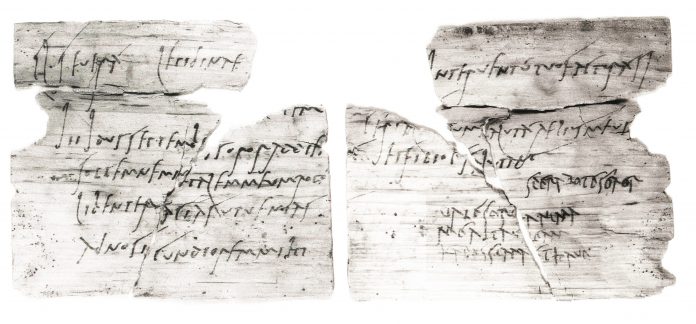Main Image: Party invitation from Claudia Severa to Sulpicia Lepidina at Vindolanda. © The Vindolanda Trust
On this day nearly 2,000 years ago a birthday party was held for Claudia Severa, the wife of a Roman officer. How do we know this? Because the party invitation sent to the wife of the camp commander at Vindolanda, a Roman fort near Hadrian’s Wall, survives to this day.
The ancient invitation written in ink on wood is just one of the thousands of voices of people from Roman Britain brought back to life in the most comprehensive ever web-based archive of Roman writing.
The Roman Inscriptions of Britain Online website has been launched by the University of Nottingham-led international research group LatinNow. It’s the culmination of years of work by team member Scott Vanderbilt.
The archive is the first complete digital library of these ancient writings to be made publicly available and offers a fascinating insight into life in Britain under the Romans.

Send more Beer!
From a Roman soldier’s note asking for more beer to be sent to a fort near Hadrian’s Wall, to proof that Romans wore underpants, the new archive contains some gems that have never before been available in one searchable website.
The Romans ruled Britain from AD 43 to around 410 and their legacy remains today in British society, not least through its alphabet, roads and cities. Writing from Roman Britain has been found by antiquarians and archaeologists over the centuries in stone, wood, metal and pottery from across the country. The new website gives the public access to centuries-old finds and the most recent exciting discoveries, including the Bloomberg tablets – more than 400 wooden writing tablets excavated by archaeologists from MOLA from the site of the new Bloomberg European Headquarters in London between 2010 and 2014.

Most of the Bloomberg tablets date to the second half of the first century AD and contain some of the earliest writing ever found in Britain. One of the tablets is the oldest known financial document from the City of London. It was written by a merchant asking to be paid his 105 denarii for goods delivered on the 8th January AD 57. Another tablet dates from around AD 70 and shows an address, ‘Londinio Mogontio’, meaning ‘In London, to Mogontius’. This is the earliest known written reference to London. You can see it along with 600 of the 14,000 artefacts that were found on the Bloomberg archaeological site, on display at London Mithraeum Bloomberg.
Vindolanda Tablets
The famous Vindolanda ink writing tablets, first found in the 1970s and still being uncovered through the wonderful work of the Vindolanda Trust, are also featured on the new website – all 773 published texts. They are thin, postcard-sized sheets of wood which were written on with a carbon-based ink, some of which are on display at the British Museum and at Vindolanda. Inscribed by the soldiers, officers and their wives and families stationed there between AD 85 and 130 AD, the messages offer an insight into all aspects of life at the garrison including the living conditions and even complaints about the British weather!
Guy de la Bédoyère, Author of Roman Britain. A New History said:
“The RIB website is an outstanding game-changing digital resource for anyone studying the history and archaeology of Roman Britain. It has created the benchmark for any website dealing with ancient inscriptions from any time or place – superbly easy to use and search and absolutely indispensable. Scott Vanderbilt is to be congratulated for advancing the study of this material in one huge leap and giving the work of the scholars responsible for the original research a whole new life for a new generation.”
Dr Alex Mullen, from the University of Nottingham’s Department of Classics and Archaeology, said: “Roman Britain might not have as many written texts as some of the other provinces of the Roman Empire, but our long obsession with collecting them and publishing them systematically means we have a record that is second to none. This fantastic resource assembles everything in one place, with access to the texts, images, archaeological context for anyone working on, or interested in, Roman Britain. If you want to find out what is in your local museum you can at the click of a button. Or you could chase up the written evidence for a solider whose name you know. All of this is made possible by whizzy computer encoding behind the scenes and generous support of the European Research Council and archaeologists and institutions across the country.”
The Roman Inscriptions of Britain website is part of LatinNow, an interdisciplinary research and educational project funded by the European Research Council. It aims to raise the profile of the history of the Romans in Europe and the impact they have had on culture, politics, languages and society. In particular the project is investigating where, how, when and why the Latin language emerged as dominant and what this means for local identities and languages.

